Turkish Armageddon. How the Ottoman Empire Perished
Situation at the front
The 1917 campaign of the Mesopotamian and Palestinian fronts was successful for the Entente. In Mesopotamia, the British, assisted by the Russian corps of Baratov, defeated the 6 of the Turkish army in the area of Kut-el-Amar, occupied Baghdad.
On the Palestinian front 31 October 1917, the battle for Beersheba began. On November 6, the Ottoman front near Gaza and Beersheba was broken and the Turkish troops began a general retreat. The Allies invaded Palestine and captured the most important settlements - Jaffa and Jerusalem. Further offensive developed extremely slowly. By the end of the year, the fatigue of the troops, and especially the rains that had begun, and the lack of roads, forced the British to stop the offensive. At the front there was a lull, which continued at the beginning of 1918. The British command was engaged in the improvement of communications and the construction of the railway.
21 January 1918 The High Military Council of the Entente decided to "take a decisive attack on Turkey in order to destroy the Turkish armies and smash the resistance of the Turks." The position of the Ottoman Empire during this period was critical. The Turkish army experienced an acute shortage of weapons and ammunition. The economy - industry, finance, trade, agriculture, which in peacetime could hardly breathe, collapsed under the weight of military problems and mediocre government policies. The people and the troops were starving. The ware supply has virtually ceased. There has been an increase in epidemic diseases. Soldiers massively deserted, the number of the army constantly decreased. The corps, which were sent to the front in 1917, lost on the way to the front line up to 40% personnel. In army units, suicide and self-harm have become routine. Deserters created gangster, chetnichesky groups that responded to the terror of the state, the army and the police with their terror. Struggling with desertion, banditry and resistance of national minorities, the authorities responded with even more cruelty. Punitive detachments destroyed and burned whole healings, devastated the area. Thus, the combat capability of the Turkish army plummeted, and the country itself was falling apart, sinking in chaos.
In addition, the Turkish military-political leadership launched an intervention in the Caucasus, taking advantage of the collapse and turmoil in Russia. That is, the troops that could reinforce the defense in the Mesopotamian and Syrian-Palestinian fronts acted in the Caucasus. Brest-Litovsk peace from 3 March 1918 of the year established peace between the Ottoman Empire and Soviet Russia. However, the Young Turk government launched an intervention in the Transcaucasus, still hoping to create a "Turkic" empire and reward itself for the losses in Hejaz, Palestine and Iraq. At the end of April 1918, the Turks captured Kars and Batum. The Turkish agents were active among the mountaineers of the North Caucasus, urging them to revolt. 15 May 1918, the Turks took Alexandropol, September 15 captured Baku. The occupants staged a massacre in Baku, massacred thousands of Armenians. The military adventure of the Turkish army in the Caucasus, the greed of the Young Turkish government, made it easier for the British to defeat the Ottoman Empire.
On the Mesopotamian front, fighting began in March 1918. The troops of the 6 of the Turkish army stretched along the 500-kilometer front from Hanat-Makinsk to the Euphrates. The British forces included six infantry divisions, a cavalry division, and numerous separate units — a total of 447 thousand people (in combat units on the front line there were 170 thousand people). In the Mosul direction, British troops occupied a number of settlements (Heath, Kifri, Tuz, Kirkuk), but then left them and moved to their former positions north of Baghdad. From May to September there was a lull, during which the British were preparing for larger operations.
Map source: A. M. Zayonchkovsky. World War 1914-1918
Plans and forces of the parties
In the Syrian-Palestinian theater at the end of April 1918, it was planned to launch an offensive with the aim of defeating the Turkish army. Great work was done by the British to improve the supply routes, the railway to Ranti was built. But the spring offensive of the German army on the French front foiled British plans in Palestine. I had to transfer troops from here to France, and in Palestine confine myself to local operations. After the German offensive began to run out of steam in France, the British returned to the preparation of an offensive in Palestine. The British troops under the command of Edmund Allenby, who received reinforcements, numbered 69 thousand people (including 12 thousand cavalry, 540 guns and 90 aircraft).
The Turkish 4, 7, and 8 armies occupied defenses on the front from the Mediterranean coast to the northern tip of the Dead Sea and another 30-40 km, the eastern river. Jordan. The main command of Turkish troops in Palestine in February 1918 was entrusted to the German General Liman von Sanders. Each Turkish army consisted of several divisions, but of such a weak composition that the size of the army barely constituted one normal division. The total number of Turkish troops in Palestine was 34 thousand people (including 2 thousand cavalry), 402 guns and 25 aircraft. The Turkish command planned to launch an offensive in late February - early March 1918 of the year in order to reject the British troops and eliminate the threat they posed not only to Palestine and Syria, but also to the Southern Anatolia and Mesopotamian front. But because of the collapse of the army, supplies and military adventures in the Caucasus, they did not dare to attack.
The British command's intention was to deliver powerful blows on the flanks and surround the main forces of the Turks. The development of success was entrusted to the cavalry (the "equestrian corps of the desert" - three divisions), for which it focused on the left flank in the Jaffa region. On the right flank, the operation was carried out by troops of the Arabs who had risen against the Turks. In order to achieve surprise, operational masking measures were widely used (misinformation, false rearrangements, imitation of the work of large headquarters, mock-ups). So, in the east of Palestine, in the Jordan Valley, the British built a false military camp with 15 thousands of horse stuffed animals, so that the Turks would think that the main blow would be here, and not in the coastal strip. Also, the infantry was transferred here demonstratively, in the afternoon, on foot, and with a maximum of noise, and at night they secretly took it back in trucks to the seaside district.
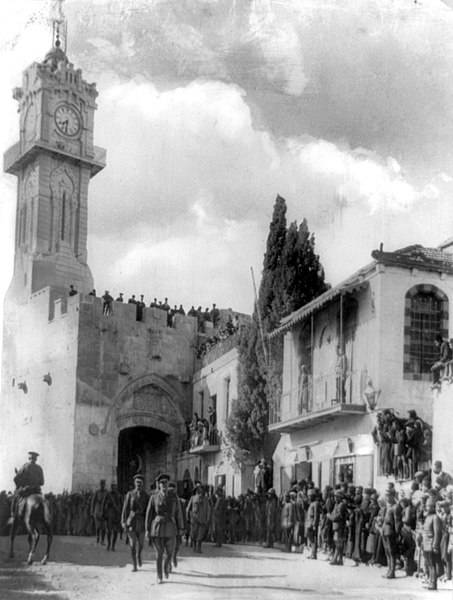
General Allenby's British Army Enter Jerusalem
Battle
The British offensive began on 4 hours 30 minutes 19 September. After the 15-minute powerful artillery preparation, infantry under the cover of the firing shaft moved into the attack. British and Indian infantry divisions attacked Turkish positions in the Sharon area and broke through all defensive positions at the front of 13 kilometers, surrounding two Turkish corps in the surrounding mountains. Indian and Australian units captured communications centers in the depths of the Ottoman defense, and British aircraft bombed the work of the Turkish military headquarters, which disrupted troop control. At the same time, another successful attack of the British took place in 20 kilometers to the east, in the area of Nablus (the city was captured by September 20). The attackers from the sea and from Nablus joined in 20 kilometers to the north, in the region of Megiddo, closing the encirclement ring.
The Turkish front was broken from Rafat to the sea (40 km along the front) and a cavalry corps penetrated the breakthrough, which advanced 40 km in depth by the end of the day. A series of small battles with demoralized Turks who attempted to break out of the encirclement took place in the surrounding cities: near Nazareth, which was occupied by the British 21 in September, near the towns of Jenin and Afula. In Nazareth, where the headquarters of the Turkish army was located, they nearly took prisoner von Sanders captive. Developing an advance to the north, the 23 of September the Allies occupied Haifa, and then the Acre, which lies 10 kilometers to the north. At the same time, the Arab allies of the British attacked an important transportation hub in Dara'a (in southern Syria) from 17 September, through which supplies were supplied to the Turkish armies, and destroyed the railway lines. September 21 British units began to strike in the Jordan Valley in the direction of Amman. Not having the strength to offer serious resistance, the remaining Turkish troops fled. As a result, over the week the Turks in Palestine were defeated and in fact ceased to exist as a military force. Of all the Ottoman troops in Palestine, only 6 thousand soldiers avoided being captured.
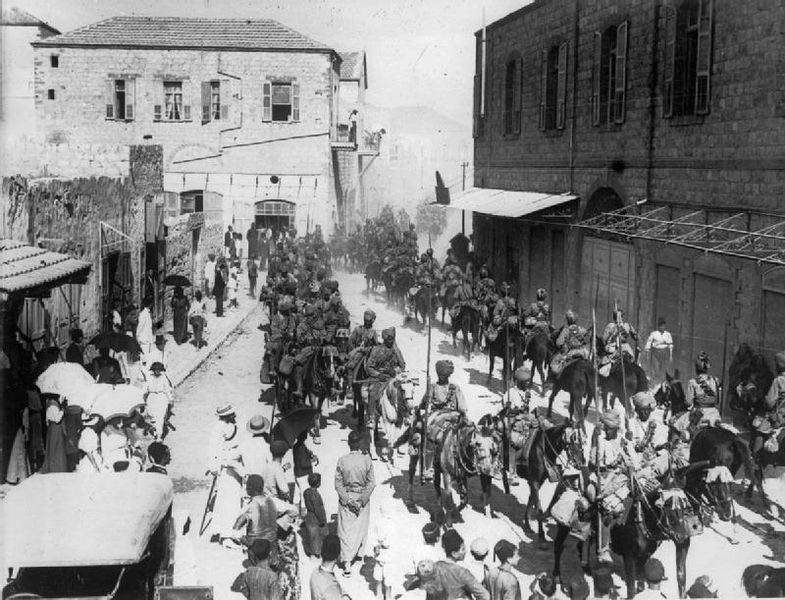
Indian cavalry in Haifa. 1918 year
Thus, the Turks in Palestine were defeated, but in Syria they no longer resisted. Played its numerical and qualitative superiority of the allied forces. The Turkish army was already so decomposed that after the first setbacks it could not gather strength, regroup, transfer reserves and repulse the enemy in new positions. The complete disaster of the Turkish army and the country, prepared by previous years, began. The British played a major role in the successful operation. aviation. Having seized air supremacy thanks to its considerable numerical superiority, it bombarded and fired from the air the headquarters of the Turks, disrupting communications and command and control.
British military historian Neil Grant wrote: “During the battle itself, there were no violent clashes: victory was achieved by superior strategy, plus a predominance of soldiers and weapons in numbers, and also due to the rapid mobility of relatively lightly armed units. ... Allenby also had full control in the air, exercising it so effectively that Turkish aircraft could not rise from the ground at all, and the successful bombardment of the telegraph and telephone centers violated Turkish communication lines. When the cavalry broke through to Nazareth where the Turkish General Staff was, the commanders themselves barely carried off their legs. ”
Edmund Allenby himself wrote: “I passed by the hospital and told the wounded that they had done the most important thing in the war - they completely defeated the two armies in 36 hours! The 7 and 8 of the Turkish army does not currently exist, and these were the best troops in the Turkish Empire. " The Allies were amazed how the Turkish army, which had resisted them for almost four years, collapsed so quickly in a matter of days.
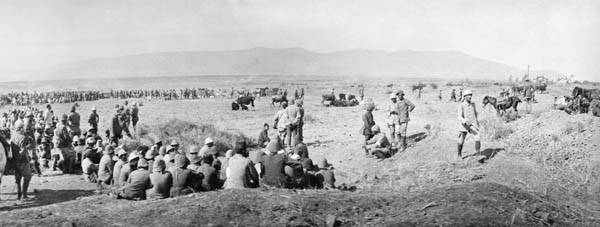
Turkish prisoners captured during the battle of Megiddo
Pursuing the enemy
After that, the allies have already attacked, almost without meeting the resistance of the enemy. 25 September Australian cavalry broke through to the Sea of Galilee and captured the city of Tiberias. The small Ottoman garrison of the city did not expect the appearance of enemies here and was taken by surprise. The Turks preferred to capitulate. Also on this day, a small Ottoman-German military camp in Samaha on the shores of the Sea of Galilee was defeated. The Turks suffered a major setback in the Amman area. The city had strong fortifications and natural defenses in the form of swamps. But only a day was defended and 2,5 thousand. The Turkish garrison chose to lay down weapon. September 27, the Arab allies of the British occupied the city of Daraa, and the British - the bridge of the Daughters of James across the Jordan. By September 30, the Allies were already in Al-Kisva (10 kilometers south of Damascus), entering the borders of Syria.
October 1 British occupied Damascus, the winners were headed by the legendary British intelligence officer Thomas Lawrence and the son of the former sheriff of Mecca and King Hijaz Faisal ibn Hussein, who later became the king of Syria and then Iraq. In Damascus, the British, Australians and Arabs surrendered to 12 thousands of demoralized Turks, among whom were many wounded, sick and exhausted soldiers. Many of them soon died due to inadequate medical care. The British were advancing to the north and along the Mediterranean: on October 4 they captured the city of Tire. The Turks here had almost no troops and did not offer any resistance. By October 7, British troops approached Beirut, and a French landing force landed in the city itself. The city captured about 600 Ottoman soldiers. They capitulated without resistance, but British soldiers and officers complained of great exhaustion from chasing the Turks through Palestine and Lebanon. Here are the words of one of the officers: “If I were asked how I feel, I must say that as a cripple. I hope that I will never again experience a similar march, where people stomp with sunken cheeks and goggled eyes, for three weeks they did not eat anything except cookies. ”
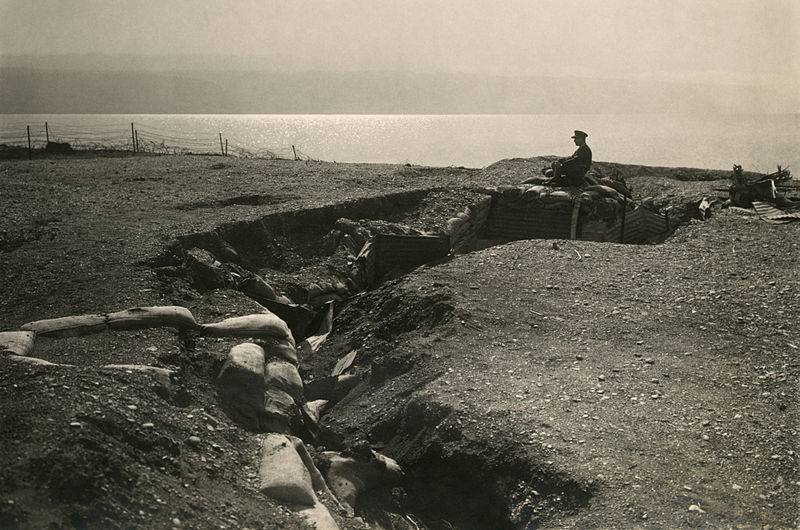
Turkish trench from the Dead Sea. 1918 year
October 10 British occupied the city of Baalbek, October 13 another squad, moving on camels and armored vehicles, entered the city of Tripoli. October 14 was busy Rayak. The surviving troops of the Turks retreated deep into Syria and tried to organize a defense near the city of Homs. But here they failed to gain a foothold. October 16 British troops surrounded and captured Homs. The rapid rush from Damascus was carried out on cars, and the storming of the city took place with the participation of armored vehicles. But not many Turks managed to capture in Homs, most managed to slip away and run further north to the city of Aleppo.
October 25 became the main battlefield of the very north of Syria, where the combined forces of the Arabs and the British remained to take the last line of defense of the Turks - the major city of Aleppo. The city was of strategic importance and was an important transportation hub. In Aleppo, the last remnants of the Turkish troops from the Palestinian front were pulled together - about 24 thousands of soldiers and officers. They tried to somehow organize General Mustafa Kemal Pasha (the future founder of the Turkish Republic of Ataturk). The former commander-in-chief of Turkish troops in Palestine, German General von Sanders, actually abandoned his army to its fate and fled. Aleppo was attacked by Arab cavalry forces led by Prince Faisal with the support of British armored vehicles. The Allies captured positions south of Aleppoi by 10 in the hours of the morning British armored cars broke into Aleppo. Simultaneously, 80 kilometers west of the city on the Mediterranean coast, the British approached Alexandrette. Mustafa Kemal, fearing another encirclement, began to hastily withdraw his troops. By evening, the British seized Aleppo. This relatively small battle was the last on the Palestinian front.
In the same period, the British won in Mesopotamia. The new British attack on Mosul began in the middle of October 1918. During one week, the 6 Turkish army suffered a crushing defeat at Qalat Sherat. 11 300 Turkish soldiers and officers with 51 artillery guns surrendered to the British. The British reached the southern borders of the Mosul vilayet and October 31 freely entered Mosul.
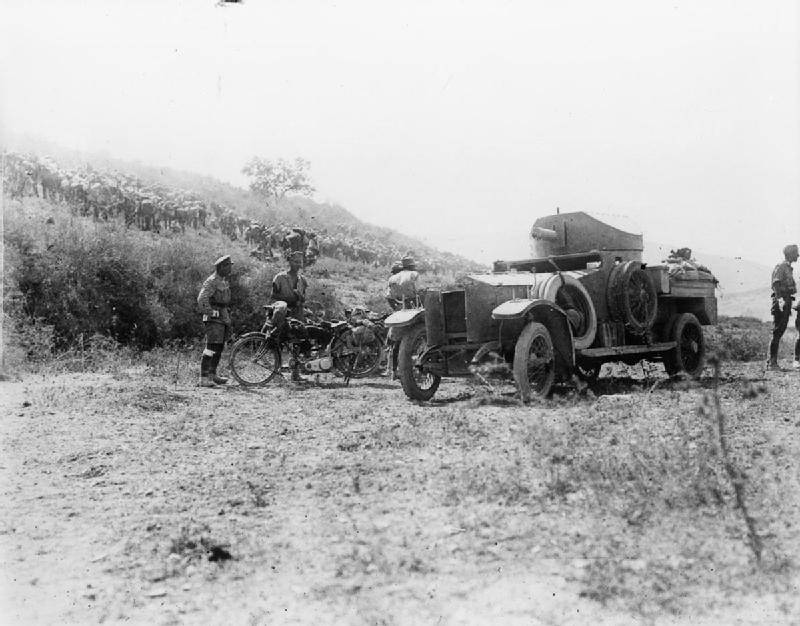
Battle of Megiddo. British patrol with armored car
Results
During the autumn operations of the 1918 campaign in the Middle East Theater, the Turkish army suffered a crushing defeat. In these battles, 75, thousands of Turkish soldiers, were captured, and a mass of weapons, including 360 guns, fell into the hands of the British. This was largely due to the aggressive policies of the Young Turk government in the Caucasus. The Turks rushed to seize the Caucasus and could not strengthen the front in Mesopotamia and Palestine, although previous campaigns showed that it was there that the Allies would continue to attack. As a result, the Entente troops captured a significant part of Mesopotamia, all of Palestine and almost all of Syria. The Ottoman Empire in the face of a complete disaster, was in a difficult situation, which was aggravated by the surrender of Bulgaria. That is, the allies, after the surrender of Sofia, had the opportunity to launch an offensive against Constantinople from the Balkan Peninsula.
October 5 Turkish government turned to US President Wilson with a peace offer. At the same time it tried to enter into direct negotiations with Britain and France. But the allies, especially the British, were in no hurry to respond until Mosul and Aleppo were captured. Armistice negotiations officially began only on October 27. They were conducted in the English military ship "Forsyth" in the port of Mudroc on the island of Lemnos, at that time captured by the British.
On October 30, 1918, in Mudros, on board the English battleship Agamemnon, Turkey signed harsh armistice conditions. On behalf of the Entente, the agreement was signed by Admiral Kalthorp on behalf of Turkey - Minister of the Navy fleet Hussein Rauf. Turkey pledged to open the straits for the passage of the Allied ships to the Black Sea, forts of the Dardanelles and the Bosphorus were transferred to the winners. All other seaports on the Black and Mediterranean Seas were transferred to the Entente. The entire Turkish Navy was transferred to the Allies. Istanbul completely broke relations with the allies (Germany and Austria-Hungary). The ground army was subject to immediate demobilization. It was allowed to leave only a small part of the forces necessary to protect the borders and maintain internal order. All stocks of weapons, ammunition and military equipment were transferred to the Allies. The ceasefire recorded the Allied occupation of Arab lands. Entente troops were also given the right to occupy any military-strategic and economic points in the country, to establish their control over its railways, transport, fuel and food supplies. The allies specifically stipulated the right to occupy Batum and Baku, then still occupied by the Turks. At noon on October 31, 1918, the day after the armistice, hostilities on the Syrian-Palestinian and Mesopotamian fronts were discontinued.
The policy of the former leadership of Turkey suffered a complete collapse and led to the death of the empire. On the night of 3 in November 1918, the leaders of the Ottoman Empire - Enver Pasha, Talaat Pasha, Jemal Pasha, prominent leaders of the party’s central committee and other high-ranking officials plunged into the German warship and fled from Istanbul to Odessa, and from there to Germany. The Young Turkish party was dissolved. Immediately after the signing of the truce, the Entente powers began to occupy the most important military-strategic areas of the former Turkish empire. Already on November 13, the allied forces of England, France, Italy, and after some time the United States entered the Golden Horn Bay, landed troops in Constantinople and occupied the fortified areas of the Black Sea Straits, appeared in the Turkish ports of the Mediterranean and Black Seas. In Mesopotamia, citing the need to ensure the security of communications of their troops, the British occupied the oil area of Mosul. The British also occupied an important port on the Mediterranean Sea - Alexandretta, established control over the Anatolian-Baghdad railway and the Black Sea ports. At the end of 1918 - the beginning of 1919, the Anglo-French troops occupied Southeastern Anatolia, and the Greeks, after landing in Izmir, began to move to Anatolia from the west.
It was the collapse of the Ottoman Empire. The “Eastern Question” was resolved in favor of the Western great powers through the actual destruction of Ottoman statehood and the occupation of Turkey. The West also used the dismemberment of Turkey to intensify its intervention in southern Russia.
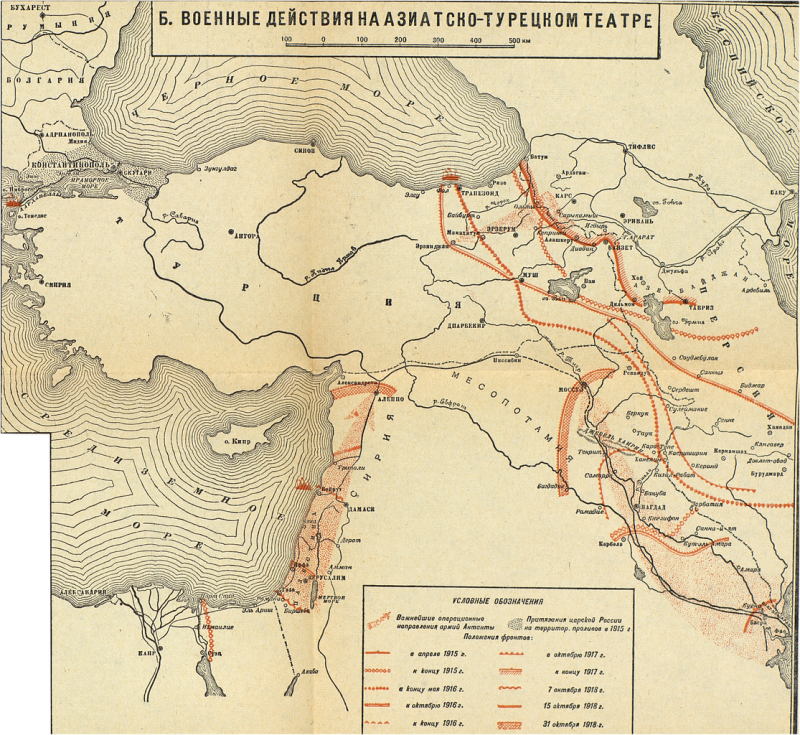
Information